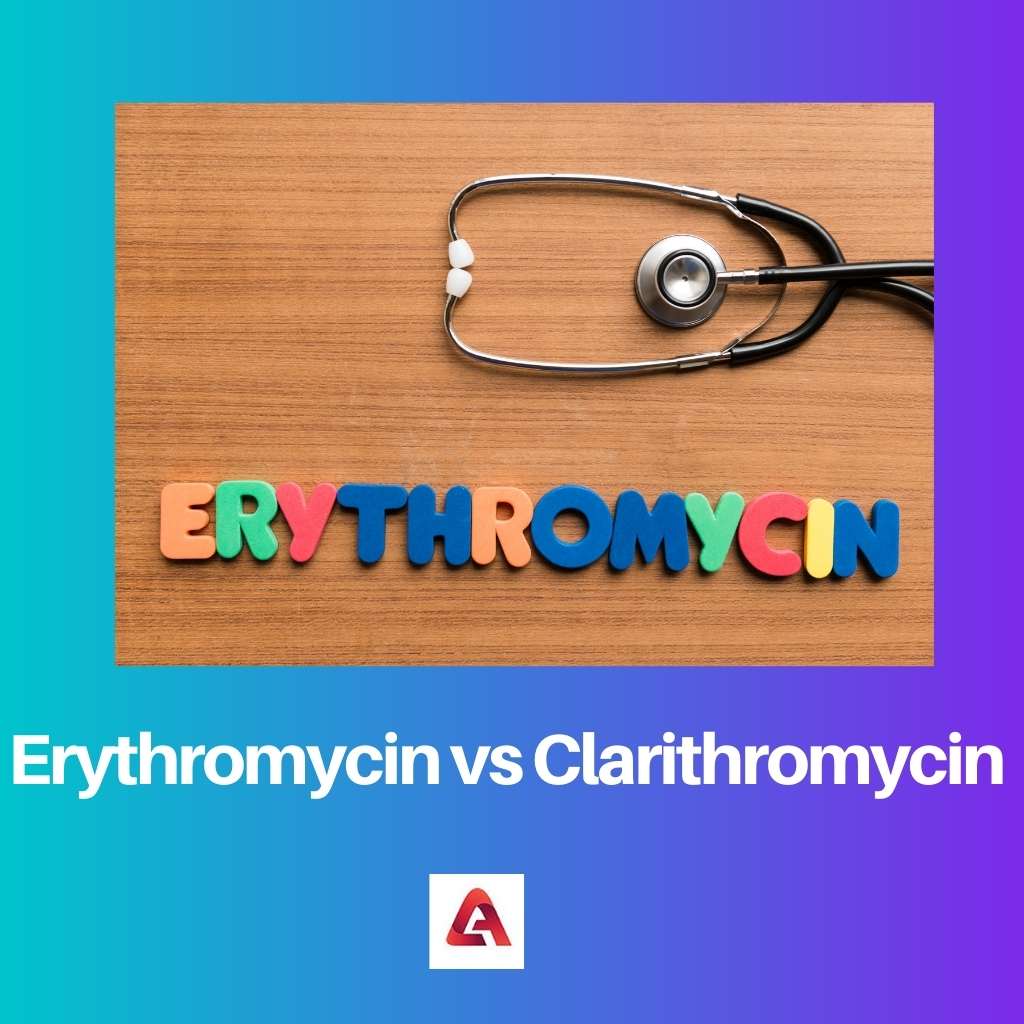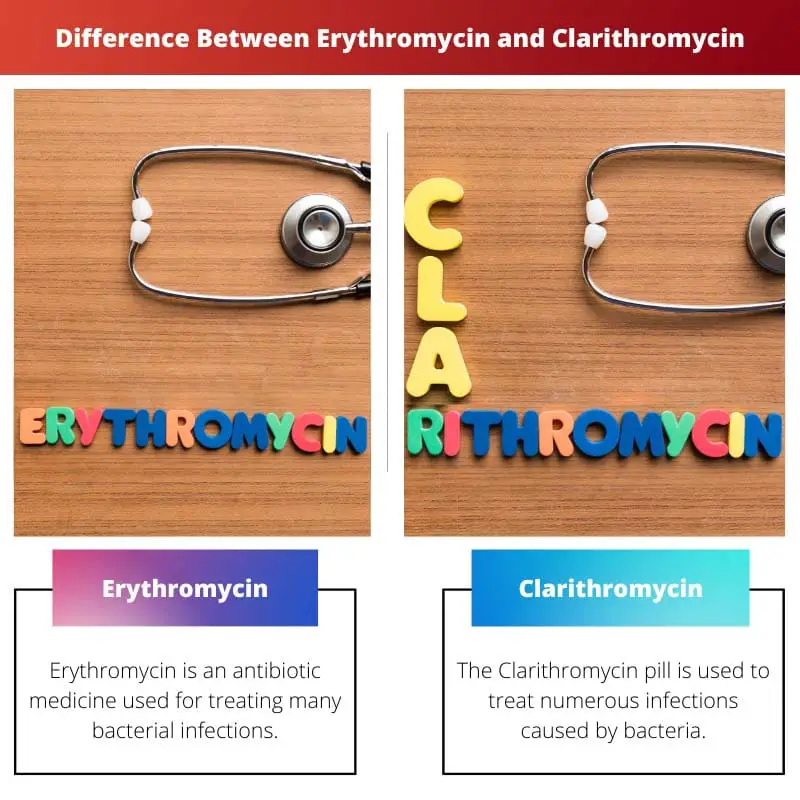Erythromycin and Clarithromycin are both types of macrolide antibiotics used for treating soft tissue infections, respiratory tract infections, urinary tract, chest infections, etc.
One antibiotic is considered as a derivative of the latter and is better intolerant.
Though being derivative of others and treating the same kind of infections, the difference arises in how the drug affects the body and the action against the bacteria.
Key Takeaways
- Erythromycin and Clarithromycin are both macrolide antibiotics, but Clarithromycin has a broader spectrum of activity against various bacteria.
- Clarithromycin exhibits fewer gastrointestinal side effects than Erythromycin, making it a more tolerable option for patients.
- Clarithromycin also has a longer half-life, allowing for less frequent dosing and better patient compliance.
Erythromycin vs Clarithromycin
Erythromycin is an antibiotic used to treat multiple bacterial infections such as respiratory tract, skin infections, and pelvic inflammatory diseases. Clarithromycin is an acid-stable and more effective derivative of erythromycin used to treat some chest infections, skin problems and ear infections.

Erythromycin is an antibiotic used for treating many bacterial infections or diseases like infections of the respiratory tract, skin, Chlamydia, pelvic inflammatory disease, and syphilis.
While pregnancy, this drug is also given to the pregnant woman to prevent the newborn from Group B streptococcal infection and helps improve gastroparesis.
The Clarithromycin pill treats numerous infections caused by bacteria and even prevents those infections beforehand. Clarithromycin is sometimes combined with anti-ulcer medicines to treat specific stomach ulcers.
The other name for Clarithromycin is a macrolide antibiotic that helps to prevent the bacteria from spreading to other parts of the body.
Comparison Table
| Parameters of Comparison | Erythromycin | Clarithromycin |
|---|---|---|
| Coverage | Poor coverage of H.flu and MSSA. | Better coverage of H.flu and MSSA. |
| How it is administered | It is taken 3 times a day i.e. every 8 hours. | This medicine is primarily distributed in tissues and fluids. |
| Distribution | This medicine concentrates in the liver and then gets transferred to bile. | Clarithromycin drugs can cause miscarriage and hence are not recommended. |
| Food consumption | It affects the absorption of the medicine. | It does not affect the absorption of the medicine. |
| Intravenous form | Erythromycin can be taken in intravenous form. | Clarithromycin is not recommended to be taken in intravenous form. |
| Pregnancy | Erythromycin drugs are recommended during pregnancy. | Clarithromycin drugs can cause miscarriage and hence not recommended. |
What is Erythromycin?
Erythromycin is a drug that is used for treating bacterial infections like respiratory tract infections which include bronchitis, pneumonia, legionnaires disease, which is an infection of the lungs, and pertussis, which is an infection causing severe coughing, diphtheria which is throat infection, STDs like syphilis and infections of ears, urinary tract, and skin.
Erythromycin also helps to treat recurrent rheumatic fever. Erythromycin falls under the medication class called macrolide antibiotics, which works as an agent that stops the bacteria from growing.
Antibiotics like erythromycin do not help to treat colds, flu, and other viral infections. When you take an antibiotic when it is not prescribed, it increases the chance of getting infected later on, which will oppose the antibiotic treatment.
Erythromycin is a delayed-release capsule, regular capsule, delayed-release tablet, regular tablet, and oral suspension medicine.
Erythromycin can be taken with or without food every 6 hours, which means four times a day, every 8 hours, that is three times a day, or 12 hours means twice a day.
This antibiotic is also used to prevent the infection of the heart in people who are suffering from dental and other procedures.
Taking erythromycin also has side effects like itchy rashes, hives, difficulty breathing or swallowing food or water, feeling lethargic, dark-coloured urine, seizures, severe diarrhoea, etc.

What is Clarithromycin?
Clarithromycin is also a macrolide antibiotic that fights infections in the body. Clarithromycin treats many bacterial infections affecting the skin and respiratory system.
Other than that, it is also combined with other medicines to treat patients suffering from stomach ulcers caused by Helicobacter pylori.
Just like erythromycin, clarithromycin also does not work for common colds and flu,. It is recommended to take the medicine till the prescription date, or it can cause infections in the future, which will resist the treatment by antibiotic drugs.
Certain medications are unsuitable for patients with some specific conditions, so it is essential to inform your doctor before taking clarithromycin.
The conditions for clarithromycin are pregnancy or breastfeeding, problems in the working of the liver and kidney, heart problems, and myasthenia gravis if you have a statin medicine cholesterol and are allergic to this medicine.
Clarithromycin should be taken exactly as your doctor prescribed you.
Many types of clarithromycin tablets are recommended two times a day, in the ,morning and evening.
If the tablet prescribed to you is a modified-release tablet, then taking one dose a day is enough, as the benefits of these tablets release slowly throughout the day.
Other types of clarithromycin, like standard-release tablets or liquid medicine and sachets, are taken before or after eating. When a clarithromycin tablet is prescribed for a child, the dosage depends on the child’s weight.
The course of this antibiotic can last from 5 to 14 days. Even though you feel you got rid of the infections, you should not stop the medication unless your doctor tells you to.

Main Differences Between Erythromycin and Clarithromycin
- Erythromycin is an antibiotic prescribed to be taken every 6 hours a day. On the other hand, clarithromycin is also an antibiotic drug prescribed to be taken every 8 hours a day.
- If erythromycin is taken after eating food, the medicine’s benefits spread slower, while food consumption does not affect the benefits of the clarithromycin drug.
- Erythromycin can be taken through intravenous form, whereas clarithromycin should not be taken through intravenous form.
- Erythromycin provides bad coverage of H.flu and MSSA, whereas clarithromycin provides better coverage of H.flu and MSSA than erythromycin.
- When women get pregnant, their doctors allow them to take erythromycin. In contrast, clarithromycin is strictly not recommended during pregnancy as it can cause miscarriage or may harm the baby in the womb.

- https://link.springer.com/article/10.1023/A:1027309703313
- https://www.sciencedirect.com/science/article/pii/S0149291896801792

The detailed comparison of Erythromycin and Clarithromycin provides valuable insights for patients and doctors in choosing the more suitable antibiotic. The emphasis on adverse effects makes it a comprehensive guide for medical practitioners and patients alike.
Absolutely, the detailed coverage of the differences between Erythromycin and Clarithromycin makes this article a valuable resource. Medical practitioners will find the information highly useful for their clinical decision making.
The post discusses in detail the contrasts between Erythromycin and Clarithromycin, examining their benefits and adverse effects. The medical history behind both is covered in detail, ensuring that the readers have a thorough understanding of the topic.
The post effectively educates readers on the contrasting features of Erythromycin and Clarithromycin. It fosters an informed decision-making process for patients undergoing antibiotic treatment.
This comprehensive overview of Erythromycin and Clarithromycin is highly informative. It successfully portrays the differences between the two antibiotics, contributing greatly to knowledge dissemination in the medical field.
Meticulous research and clear elucidation on the contrasting properties of Erythromycin and Clarithromycin. This is insightful information for both medical practitioners and the general public.
The extensive details on the distinct properties of Erythromycin and Clarithromycin provide a comprehensive understanding of the medications. An informative read for both healthcare professionals and patients.